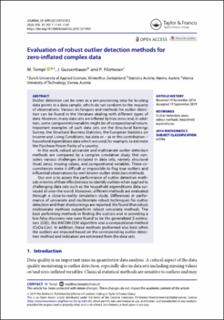Please use this identifier to cite or link to this item:
https://doi.org/10.21256/zhaw-18449Full metadata record
| DC Field | Value | Language |
|---|---|---|
| dc.contributor.author | Templ, Matthias | - |
| dc.contributor.author | Gussenbauer, J. | - |
| dc.contributor.author | Filzmoser, P. | - |
| dc.date.accessioned | 2019-10-17T12:15:28Z | - |
| dc.date.available | 2019-10-17T12:15:28Z | - |
| dc.date.issued | 2019 | - |
| dc.identifier.issn | 0266-4763 | de_CH |
| dc.identifier.issn | 1360-0532 | de_CH |
| dc.identifier.uri | https://digitalcollection.zhaw.ch/handle/11475/18449 | - |
| dc.description.abstract | Outlier detection can be seen as a pre-processing step for locating data points in a data sample, which do not conform to the majority of observations. Various techniques and methods for outlier detection can be found in the literature dealing with different types of data. However, many data sets are inflated by true zeros and, in addition, some components/variables might be of compositional nature. Important examples of such data sets are the Structural Earnings Survey, the Structural Business Statistics, the European Statistics on Income and Living Conditions, tax data or – as in this contribution – household expenditure data which are used, for example, to estimate the Purchase Power Parity of a country. In this work, robust univariate and multivariate outlier detection methods are compared by a complex simulation study that considers various challenges included in data sets, namely structural (true) zeros, missing values, and compositional variables. These circumstances make it difficult or impossible to flag true outliers and influential observations by well-known outlier detection methods. Our aim is to assess the performance of outlier detection methods in terms of their effectiveness to identify outliers when applied to challenging data sets such as the household expenditures data surveyed all over the world. Moreover, different methods are evaluated through a close-to-reality simulation study. Differences in performance of univariate and multivariate robust techniques for outlier detection and their shortcomings are reported. We found that robust multivariate methods outperform robust univariate methods. The best performing methods in finding the outliers and in providing a low false discovery rate were found to be the generalized S estimators (GSE), the BACON-EEM algorithm and a compositional method (CoDa-Cov). In addition, these methods performed also best when the outliers are imputed based on the corresponding outlier detection method and indicators are estimated from the data sets. | de_CH |
| dc.language.iso | en | de_CH |
| dc.publisher | Taylor & Francis | de_CH |
| dc.relation.ispartof | Journal of Applied Statistics | de_CH |
| dc.rights | http://creativecommons.org/licenses/by-nc-nd/4.0/ | de_CH |
| dc.subject | Outlier detection | de_CH |
| dc.subject | Zeros | de_CH |
| dc.subject | Robust method | de_CH |
| dc.subject | Household expenditure | de_CH |
| dc.subject.ddc | 005: Computerprogrammierung, Programme und Daten | de_CH |
| dc.subject.ddc | 510: Mathematik | de_CH |
| dc.title | Evaluation of robust outlier detection methods for zero-inflated complex data | de_CH |
| dc.type | Beitrag in wissenschaftlicher Zeitschrift | de_CH |
| dcterms.type | Text | de_CH |
| zhaw.departement | School of Engineering | de_CH |
| zhaw.organisationalunit | Institut für Datenanalyse und Prozessdesign (IDP) | de_CH |
| dc.identifier.doi | 10.1080/02664763.2019.1671961 | de_CH |
| dc.identifier.doi | 10.21256/zhaw-18449 | - |
| zhaw.funding.eu | No | de_CH |
| zhaw.issue | 7 | de_CH |
| zhaw.originated.zhaw | Yes | de_CH |
| zhaw.pages.end | 1167 | de_CH |
| zhaw.pages.start | 1144 | de_CH |
| zhaw.publication.status | publishedVersion | de_CH |
| zhaw.volume | 47 | de_CH |
| zhaw.publication.review | Peer review (Publikation) | de_CH |
| zhaw.author.additional | No | de_CH |
| Appears in collections: | Publikationen School of Engineering | |
Files in This Item:
| File | Description | Size | Format | |
|---|---|---|---|---|
| 2020_Templ-etal_Robust-outlier-detection-complex-data.pdf | 2.15 MB | Adobe PDF |  View/Open |
Show simple item record
Templ, M., Gussenbauer, J., & Filzmoser, P. (2019). Evaluation of robust outlier detection methods for zero-inflated complex data. Journal of Applied Statistics, 47(7), 1144–1167. https://doi.org/10.1080/02664763.2019.1671961
Templ, M., Gussenbauer, J. and Filzmoser, P. (2019) ‘Evaluation of robust outlier detection methods for zero-inflated complex data’, Journal of Applied Statistics, 47(7), pp. 1144–1167. Available at: https://doi.org/10.1080/02664763.2019.1671961.
M. Templ, J. Gussenbauer, and P. Filzmoser, “Evaluation of robust outlier detection methods for zero-inflated complex data,” Journal of Applied Statistics, vol. 47, no. 7, pp. 1144–1167, 2019, doi: 10.1080/02664763.2019.1671961.
TEMPL, Matthias, J. GUSSENBAUER und P. FILZMOSER, 2019. Evaluation of robust outlier detection methods for zero-inflated complex data. Journal of Applied Statistics. 2019. Bd. 47, Nr. 7, S. 1144–1167. DOI 10.1080/02664763.2019.1671961
Templ, Matthias, J. Gussenbauer, and P. Filzmoser. 2019. “Evaluation of Robust Outlier Detection Methods for Zero-Inflated Complex Data.” Journal of Applied Statistics 47 (7): 1144–67. https://doi.org/10.1080/02664763.2019.1671961.
Templ, Matthias, et al. “Evaluation of Robust Outlier Detection Methods for Zero-Inflated Complex Data.” Journal of Applied Statistics, vol. 47, no. 7, 2019, pp. 1144–67, https://doi.org/10.1080/02664763.2019.1671961.
Items in DSpace are protected by copyright, with all rights reserved, unless otherwise indicated.